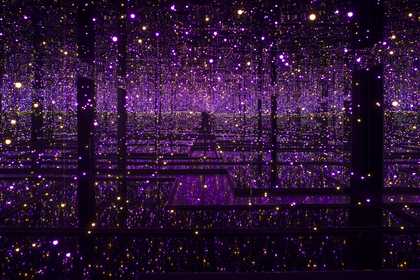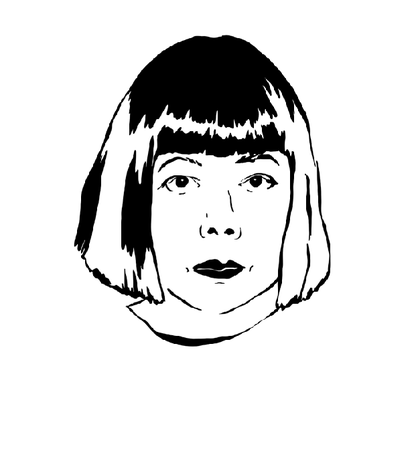
Portrait by Aurélie Garnier
Japanese artist Yayoi Kusama is a phenomenon. Through her talent, determination and vision she’s spent eight decades taking on the white, male art establishment – and winning. In recent years her work has found a huge new audience in her international exhibitions and on social media, from her celestial Infinity Mirrored Room installations to her expansive dot paintings.
But there’s much more to her than that. And though she’s reinvented herself and her art on several occasions, as curator Katy Wan explains, one of her main goals has always been to inspire joy and happiness.
For the Yes, but why? article series we teamed up with WePresent to tell the stories of Kusama and four other game-changing artists. Here we chose three quotes from the article to give you some insight into her world.
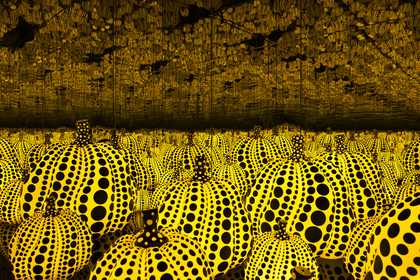
Yayoi Kusama
All the Eternal Love I Have for the Pumpkins 2016
Wood, mirror, plastic, acrylic, LED
292.4 x 415 x 415 cm
Courtesy Ota Fine Arts, Tokyo/Singapore/Shanghai and Victoria Miro, London/Venice. © YAYOI KUSAMA
1. She revolutionised New York’s male-dominated art scene
New York in the late 1950s was not a welcoming place for a young, female Japanese artist but Kusama was unstoppable. In the late 1960s she established Kusama Enterprises, her own line of dresses and textiles. This was an exercise in self-branding, based around the dots for which she was already well-known. Kusama saw that through fashion, she could reach far more people.
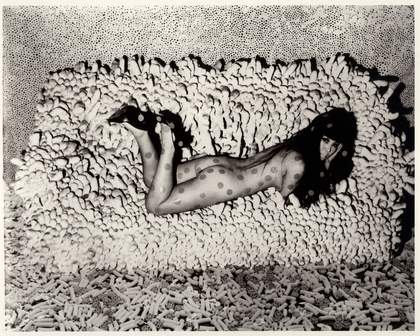
Yayoi Kusama
Untitled c.1966
Photo collage, Kusama reclining on Accumulation No.2, 1966
Courtesy Ota Fine Arts, Tokyo/Singapore/Shanghai and Victoria Miro, London/Venice. © YAYOI KUSAMA
Self-representation is an important aspect of Kusama's practice. She is immortalising her own image by harnessing the power and potential of fashion. Not only in terms of making herself recognisable, but in realising that having other people walk around in your designs is one of the best forms of advertising.
Katy Wan
2. She knows how much we love to look at ourselves

Yayoi Kusama
Infinity Mirrored Room - Filled with the Brilliance of Life 2011
Room with mirror, LED lights, water pool
296 x 622.4 x 622.4 cm
Courtesy Ota Fine Arts, Tokyo/Singapore/Shanghai and Victoria Miro, London/Venice. © YAYOI KUSAMA
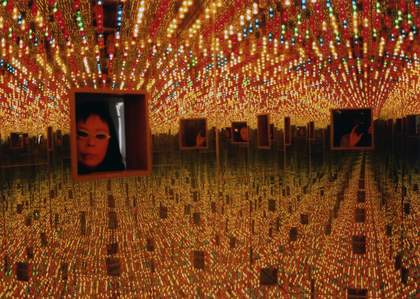
Yayoi Kusama
Infinity Mirror Room – Love-forever 1966/1994
Wood, mirrors, metal and lightbulbs
210 x 240 x 205 cm
Courtesy Ota Fine Arts, Tokyo/Singapore/Shanghai and Victoria Miro, London/Venice. © YAYOI KUSAMA
Of course, her early works are a revelation. Her works in painting and mixed media, and sculpture as well. But I think for many people, the culmination of this are her Infinity Mirrored Rooms, which are these spaces. They are whole room constructions.
And I think something that's also worth noting is that, the idea of the Infinity Mirrored Room really places Kusama within a much longer trajectory of art history. If we think about artists since the Renaissance who were thinking about perspective and philosophies of phenomenology. This idea of the mirror really makes you question your sense of self, your sense of space. I think these two ideas of self and space are really present in Kusama's works. That's what the idea of the Infinity Mirrored Room is tackling.
Katy Wan
3. She paved the way for some of art’s best-known names
In New York Kusama was part of an important network of artists who were redefining what art could be. She was a close friend of Joseph Cornell and Donald Judd (whose studio was just above hers, and who was one of her first US collectors), and a contemporary of Andy Warhol and Claes Oldenburg.

Yayoi Kusama
I'm Here, but Nothing, 2000/2012
Courtesy Ota Fine Arts, Tokyo/Singapore/Shanghai and Victoria Miro, London/Venice.
© YAYOI KUSAMA
There are arguments that her work has anticipated some of the practices of other, better known artists. Like Oldenburg, in terms of her innovations in soft sculpture which pre-dated his, and Warhol, in the form of the repeat motifs on wallpaper. Her use of repetition preceded Andy Warhol's by about three years and, as a woman working in the male-dominated art world at that time, that’s really remarkable.
Katy Wan
This is based on an interview between Maisie Skidmore and Tate curator, Katy Wan for story-telling site WePresent.

